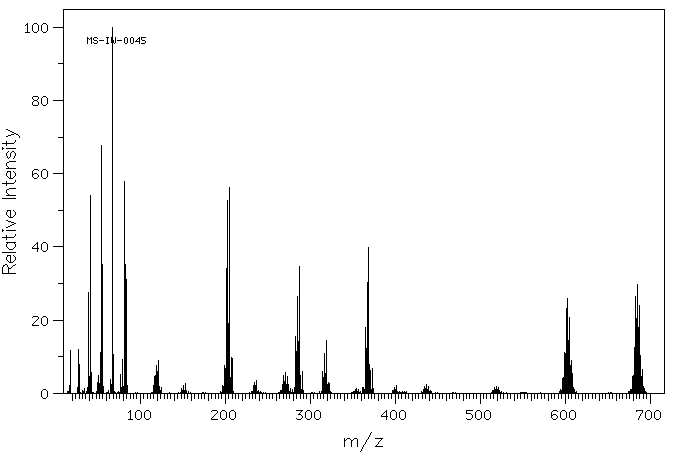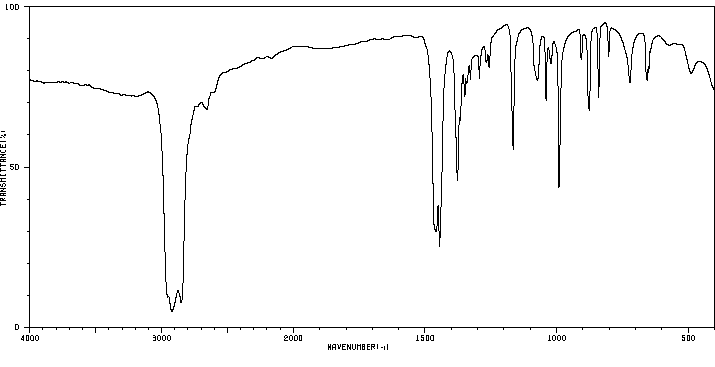双(三环己基锡(IV))硫醚 | 13121-76-1
分子结构分类
中文名称
双(三环己基锡(IV))硫醚
中文别名
双(三环己基锡)硫化物;三环锡
英文名称
bis(tricyclohexyltin)sulfide
英文别名
bis(tricyclohexyltin) sulfide;Hexacyclohexyldistannathiane;tricyclohexyl(tricyclohexylstannylsulfanyl)stannane
CAS
13121-76-1
化学式
C36H66SSn2
mdl
——
分子量
768.406
InChiKey
NBTHYJWPOYZDHL-UHFFFAOYSA-N
BEILSTEIN
——
EINECS
——
-
物化性质
-
计算性质
-
ADMET
-
安全信息
-
SDS
-
制备方法与用途
-
上下游信息
-
文献信息
-
表征谱图
-
同类化合物
-
相关功能分类
-
相关结构分类
物化性质
-
熔点:130-132 °C(lit.)
-
沸点:669.8±38.0 °C(Predicted)
计算性质
-
辛醇/水分配系数(LogP):15.46
-
重原子数:39
-
可旋转键数:8
-
环数:6.0
-
sp3杂化的碳原子比例:1.0
-
拓扑面积:25.3
-
氢给体数:0
-
氢受体数:1
安全信息
-
危险等级:6.1(b)
-
危险品标志:Xn
-
安全说明:S26,S37/39
-
危险类别码:R20/21/22,R36/37/38
-
海关编码:2931909016
-
包装等级:III
-
危险类别:6.1(b)
-
危险品运输编号:UN 3146 6.1/PG 3
SDS
模块 1. 化学品
1.1 产品标识符
: 双(三环己基锡(IV))硫化物
产品名称
1.2 鉴别的其他方法
无数据资料
1.3 有关的确定了的物质或混合物的用途和建议不适合的用途
仅用于研发。不作为药品、家庭或其它用途。
模块 2. 危险性概述
2.1 GHS-分类
急性毒性, 经口 (类别 4)
急性毒性, 吸入 (类别 4)
急性毒性, 经皮 (类别 4)
皮肤刺激 (类别 2)
眼睛刺激 (类别 2A)
特异性靶器官系统毒性(一次接触) (类别 3)
2.2 GHS 标记要素,包括预防性的陈述
象形图
警示词 警告
危险申明
H302 吞咽有害。
H312 皮肤接触有害。
H315 造成皮肤刺激。
H319 造成严重眼刺激。
H332 吸入有害。
H335 可能引起呼吸道刺激。
警告申明
预防措施
P261 避免吸入粉尘/烟/气体/烟雾/蒸气/喷雾.
P264 操作后彻底清洁皮肤。
P270 使用本产品时不要进食、饮水或吸烟。
P271 只能在室外或通风良好之处使用。
P280 穿戴防护手套/ 眼保护罩/ 面部保护罩。
事故响应
P301 + P312 如果吞咽并觉不适: 立即呼叫解毒中心或就医。
P302 + P352 如果皮肤接触:用大量肥皂和水清洗。
P304 + P340 如吸入: 将患者移到新鲜空气处休息,并保持呼吸舒畅的姿势。
P305 + P351 + P338 如与眼睛接触,用水缓慢温和地冲洗几分钟。如戴隐形眼镜并可方便地取
出,取出隐形眼镜,然后继续冲洗.
P312 如感觉不适,呼救中毒控制中心或医生.
P322 具体处置(见本标签上提供的急救指导)。
P330 漱口。
P332 + P313 如觉皮肤刺激:求医/就诊。
P337 + P313 如仍觉眼睛刺激:求医/就诊。
P362 脱掉沾污的衣服,清洗后方可再用。
安全储存
P403 + P233 存放于通风良的地方。 保持容器密闭。
P405 存放处须加锁。
废弃处置
P501 将内容物/ 容器处理到得到批准的废物处理厂。
2.3 其它危害物 - 无
模块 3. 成分/组成信息
3.1 物 质
: C36H66SSn2
分子式
: 768.39 g/mol
分子量
组分 浓度或浓度范围
Bis(tricyclohexyltin(IV)) sulfide
<=100%
化学文摘登记号(CAS 13121-76-1
No.)
模块 4. 急救措施
4.1 必要的急救措施描述
一般的建议
请教医生。 向到现场的医生出示此安全技术说明书。
吸入
如果吸入,请将患者移到新鲜空气处。 如呼吸停止,进行人工呼吸。 请教医生。
皮肤接触
用肥皂和大量的水冲洗。 请教医生。
眼睛接触
用大量水彻底冲洗至少15分钟并请教医生。
食入
切勿给失去知觉者通过口喂任何东西。 用水漱口。 请教医生。
4.2 主要症状和影响,急性和迟发效应
据我们所知,此化学,物理和毒性性质尚未经完整的研究。
4.3 及时的医疗处理和所需的特殊处理的说明和指示
无数据资料
模块 5. 消防措施
5.1 灭火介质
灭火方法及灭火剂
用水雾,抗乙醇泡沫,干粉或二氧化碳灭火。
5.2 源于此物质或混合物的特别的危害
碳氧化物, 硫氧化物, 锡/氧化锡
5.3 给消防员的建议
如必要的话,戴自给式呼吸器去救火。
5.4 进一步信息
无数据资料
模块 6. 泄露应急处理
6.1 作业人员防护措施、防护装备和应急处置程序
使用个人防护用品。 避免粉尘生成。 避免吸入蒸气、烟雾或气体。 保证充分的通风。
人员疏散到安全区域。 避免吸入粉尘。
6.2 环境保护措施
不要让产品进入下水道。
6.3 泄漏化学品的收容、清除方法及所使用的处置材料
收集和处置时不要产生粉尘。 扫掉和铲掉。 放入合适的封闭的容器中待处理。
6.4 参考其他部分
丢弃处理请参阅第13节。
模块 7. 操作处置与储存
7.1 安全操作的注意事项
避免接触皮肤和眼睛。 避免形成粉尘和气溶胶。
在有粉尘生成的地方,提供合适的排风设备。一般性的防火保护措施。
7.2 安全储存的条件,包括任何不兼容性
贮存在阴凉处。 使容器保持密闭,储存在干燥通风处。
7.3 特定用途
无数据资料
模块 8. 接触控制和个体防护
8.1 容许浓度
最高容许浓度
没有已知的国家规定的暴露极限。
8.2 暴露控制
适当的技术控制
根据良好的工业卫生和安全规范进行操作。 休息前和工作结束时洗手。
个体防护设备
眼/面保护
带有防护边罩的安全眼镜符合 EN166要求请使用经官方标准如NIOSH (美国) 或 EN 166(欧盟)
检测与批准的设备防护眼部。
皮肤保护
戴手套取 手套在使用前必须受检查。
请使用合适的方法脱除手套(不要接触手套外部表面),避免任何皮肤部位接触此产品.
使用后请将被污染过的手套根据相关法律法规和有效的实验室规章程序谨慎处理. 请清洗并吹干双手
所选择的保护手套必须符合EU的89/686/EEC规定和从它衍生出来的EN 376标准。
身体保护
全套防化学试剂工作服, 防护设备的类型必须根据特定工作场所中的危险物的浓度和数量来选择。
呼吸系统防护
如须暴露于有害环境中,请使用P95型(美国)或P1型(欧盟 英国
143)防微粒呼吸器。如需更高级别防护,请使用OV/AG/P99型(美国)或ABEK-P2型 (欧盟 英国 143)
防毒罐。
呼吸器使用经过测试并通过政府标准如NIOSH(US)或CEN(EU)的呼吸器和零件。
模块 9. 理化特性
9.1 基本的理化特性的信息
a) 外观与性状
形状: 粉末
颜色: 白色
b) 气味
无数据资料
c) 气味阈值
无数据资料
d) pH值
无数据资料
e) 熔点/凝固点
熔点/凝固点: 130 - 132 °C - lit.
f) 沸点、初沸点和沸程
无数据资料
g) 闪点
无数据资料
h) 蒸发速率
无数据资料
i) 易燃性(固体,气体)
无数据资料
j) 高的/低的燃烧性或爆炸性限度 无数据资料
k) 蒸气压
无数据资料
l) 蒸汽密度
无数据资料
m) 密度/相对密度
无数据资料
n) 水溶性
无数据资料
o) n-辛醇/水分配系数
无数据资料
p) 自燃温度
无数据资料
q) 分解温度
无数据资料
r) 粘度
无数据资料
模块 10. 稳定性和反应活性
10.1 反应性
无数据资料
10.2 稳定性
无数据资料
10.3 危险反应
无数据资料
10.4 应避免的条件
无数据资料
10.5 不相容的物质
氧化剂强氧化剂
10.6 危险的分解产物
其它分解产物 - 无数据资料
模块 11. 毒理学资料
11.1 毒理学影响的信息
急性毒性
无数据资料
皮肤刺激或腐蚀
无数据资料
眼睛刺激或腐蚀
无数据资料
呼吸道或皮肤过敏
无数据资料
生殖细胞致突变性
无数据资料
致癌性
IARC:
此产品中没有大于或等于 0。1%含量的组分被 IARC鉴别为可能的或肯定的人类致癌物。
生殖毒性
无数据资料
特异性靶器官系统毒性(一次接触)
吸入 - 可能引起呼吸道刺激。
特异性靶器官系统毒性(反复接触)
无数据资料
吸入危险
无数据资料
潜在的健康影响
吸入 吸入有害。 引起呼吸道刺激。
摄入 误吞对人体有害。
皮肤 通过皮肤吸收有害。 造成皮肤刺激。
眼睛 造成严重眼刺激。
接触后的征兆和症状
据我们所知,此化学,物理和毒性性质尚未经完整的研究。
附加说明
化学物质毒性作用登记: 无数据资料
模块 12. 生态学资料
12.1 生态毒性
无数据资料
12.2 持久性和降解性
无数据资料
12.3 潜在的生物累积性
无数据资料
12.4 土壤中的迁移性
无数据资料
12.5 PBT 和 vPvB的结果评价
无数据资料
12.6 其它不良影响
无数据资料
模块 13. 废弃处置
13.1 废物处理方法
产品
联系专业的拥有废弃物处理执照的机构来处理此物质。
与易燃溶剂相溶或者相混合,在备有燃烧后处理和洗刷作用的化学焚化炉中燃烧
受污染的容器和包装
按未用产品处置。
模块 14. 运输信息
欧洲陆运危规: 3146 国际海运危规: 3146 国际空运危规: 3146
14.2 联合国运输名称
欧洲陆运危规: ORGANOTIN COMPOUND, SOLID, N.O.S. (Bis(tricyclohexyltin(IV)) sulfide)
国际海运危规: ORGANOTIN COMPOUND, SOLID, N.O.S. (Bis(tricyclohexyltin(IV)) sulfide)
国际空运危规: Organotin compound, solid, n.o.s. (Bis(tricyclohexyltin(IV)) sulfide)
14.3 运输危险类别
欧洲陆运危规: 6.1 国际海运危规: 6.1 国际空运危规: 6.1
14.4 包裹组
欧洲陆运危规: III 国际海运危规: III 国际空运危规: III
14.5 环境危险
欧洲陆运危规: 否 国际海运危规 国际空运危规: 否
海洋污染物(是/否): 是
14.6 对使用者的特别提醒
无数据资料
模块 15 - 法规信息
N/A
模块16 - 其他信息
N/A
反应信息
-
作为反应物:描述:双(三环己基锡(IV))硫醚 、 1,4-di(3-cyanophenyl)butanedione 在 三氯化硼 作用下, 以 噻吩 、 正己烷 、 氯仿 、 乙酸乙酯 、 甲苯 为溶剂, 以63%的产率得到2,5-bis-(3-cyanophenyl) thiophene参考文献:名称:Small molecule inhibition of RNA/ligand binding摘要:揭示了一种抑制配体与RNA结合的方法,该抑制是由结合到RNA的小有机分子介导的,从而抑制配体结合。一种首选的小有机分子类别是由2,5-双[3-(2-N,N-二甲基氨基丙基氨基)苯基]呋喃化合物为例。公开号:US05668165A1
-
作为产物:描述:参考文献:名称:Awasthi; Bhattacharya; Verma, Journal of the Indian Chemical Society, 1982, vol. 59, # 2, p. 264 - 268摘要:DOI:
-
作为试剂:描述:参考文献:名称:Reagents for organic synthesis. Tin-assisted sulfuration: a highly potent new method for the conversion of carbonyl units into their corresponding thiocarbonyl analogs摘要:DOI:10.1021/ja00375a027
文献信息
-
Mixed triorganotin compounds, R3SnXSnR′3: 119Sn NMR evidence for their formation in solution作者:S.J Blunden、R HillDOI:10.1016/s0022-328x(00)99808-5日期:1987.10
-
Organoindium Thiolate Oligomers: An X-ray Structural Study作者:Burl Yearwood、Shahid Ul Ghazi、Mary Jane Heeg、Nicholas Richardson、John P. OliverDOI:10.1021/om990887b日期:2000.3.6The reaction of R3In (R = methyl, tert-butyl, xylyl) with bis(tricyclohexyltin) sulfide, 2-methylpropane-2-thiol, 4,6-dimethyl-2-mercaptopyrimidine, cyclopentanethiol, cyclohexanethiol, 2,5-dimethylbenzenethiol, or 2,6-methylbenzenethiol has yielded seven new indium-sulfur complexes: m-Xyl(2)In[mu-SSn(C6H11)(3)]}(2) (2), [t-Bu2In(mu-S-C5H9)](2) (3), [t-Bu2In(mu- S-C6H11)](2) (4), t-Bu2In[mu-S(2,5-Me-2)C6H3]}(2) (5) Me2In(mu-S-t-Bu)](3) (6), t-Bu2In[mu-S(4,6-Me-2)C4N2H])(3) (7), and [Me2In[mu-S(2,6-Me-2)C6H3])(4) (8) These complexes have been studied by H-1 and C-13 NMR spectroscopy, and their structures have been determined by single-crystal X-ray diffraction techniques. 2-5 form dimeric species with planar (In-S)(2) cores, 6 forms a trimer which adopts a skew-boat conformation, 7 forms a trimer with a planar six-membered (InS)(3) ring with a secondary In-N interaction, giving rise to a pseudo-five-coordinate In atom, and 8 forms a tetramer in an extended chair conformation, the first known indium tetramer. Several of the factors of importance to the structures of these compounds, and especially those which lead to the unusual planar derivative 7, will be discussed.
-
STELIOU, K.;MRANI, MOHAMED, J. AMER. CHEM. SOC., 1982, 104, N 11, 3104-3106作者:STELIOU, K.、MRANI, MOHAMEDDOI:——日期:——
-
KANE, JOHN M.;DUDLEY, MARK W.;SORENSEN, STEPHEN M.;MILLER, FRANCIS P., J. MED. CHEM., 31,(1988) N 6, 1253-1258作者:KANE, JOHN M.、DUDLEY, MARK W.、SORENSEN, STEPHEN M.、MILLER, FRANCIS P.DOI:——日期:——
表征谱图
-
氢谱1HNMR
-
质谱MS
-
碳谱13CNMR
-
红外IR
-
拉曼Raman
-
峰位数据
-
峰位匹配
-
表征信息
同类化合物
锰,五羰基(三甲基甲锡烷基)-,(OC-6-22)-
锡烷,乙氧基三甲基-
锡烷,三丁基(1E)-1-庚烯基-
锡烷,三丁基(1-甲基-2-丁烯基)-,(Z)-
锡烷,三(1,1-二甲基乙基)乙炔基-
锡烷,(4-氯二环[2.2.1]庚-1-基)三甲基-
锡烷,(1E)-1-丁烯-3-炔基三丁基-
铝,三庚基-
铝,丁氧基二(2-甲基丙基)-
铅烷,三丁基-1-己炔基-
辛基锡
辛基氧代锡烷
膦,三(三甲基甲锡烷基)-
碳化铝
碘化三乙基铅
碘(三甲基)铅烷
硼烷胺,N,N-二(氯二甲基甲锡烷基)-1,1-二甲基-
硫烷负离子三甲基铅
硫代乙酸 S-[3-(三丁基锡烷基)丙基]酯
硒基二(三甲基锡)
癸酰(二羟基)铝
甲硫基三丁基锡烷
甲烷四基四(三甲基锡烷)
甲氧基二(2-甲基丙基)-铝
甲基锡
甲基烯丙基三正丁基锡
甲基氢化钼
甲基双(1-甲基环己基)锡烷
甲基二氯化铝
甲基三戊基锡
甲基(三丙基)锡烷
环己羧酸,2-氨基-,甲基酯,(1S,2S)-
环己基三异丙基锡烷
环己基[(三丁基锡烷基)氧基]重氮1-氧化物
环己基-三甲基锡烷
环己基(异丙基)二甲基锡烷
环丙基(三异丙基)锡烷
烯丙基三甲基锡烷
烯丙基三乙烯基锡烷
烯丙基三丁基锡
烯丙基三(3,3,4,4,5,5,6,6,7,7,8,8,8-十三氟辛基)锡烷
溴二乙基铝
溴三甲基铅
溴(异丙基)汞
溴(三乙基)铅
溴(三丁基)铅
氰酸三丁基锡烷
氯甲氧基甲基三丁基锡
氯甲基三甲基锡
氯化二己基铝








